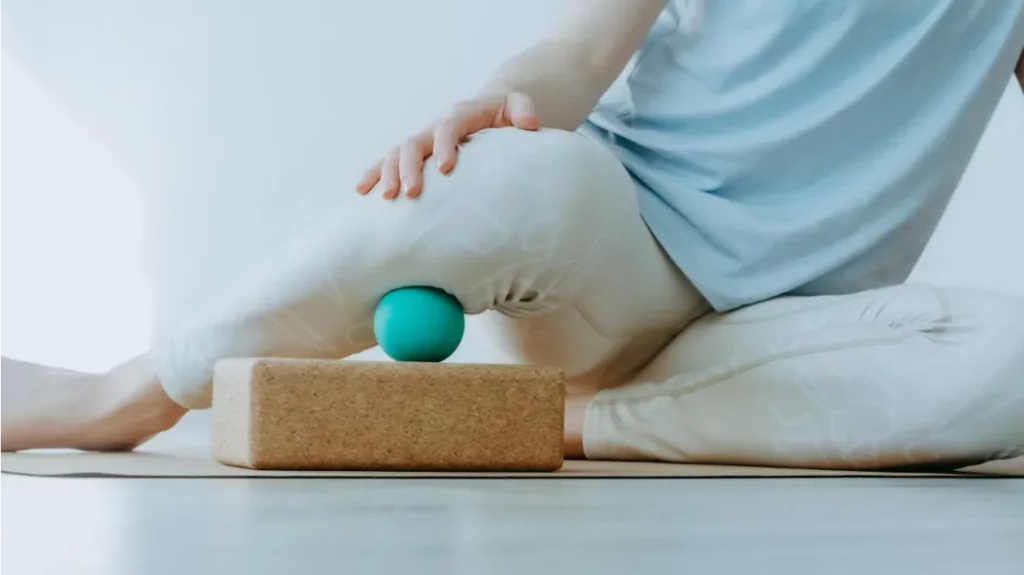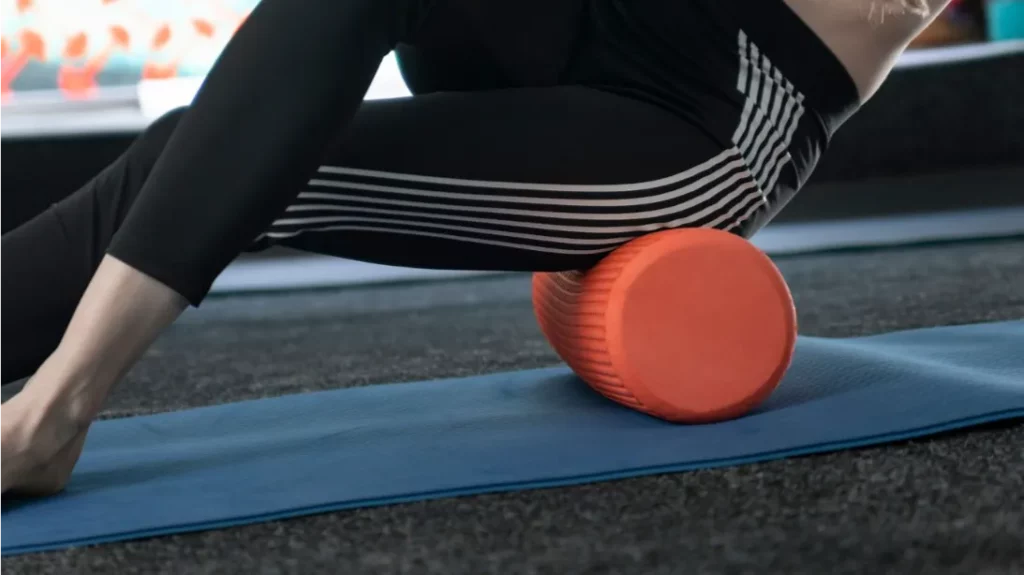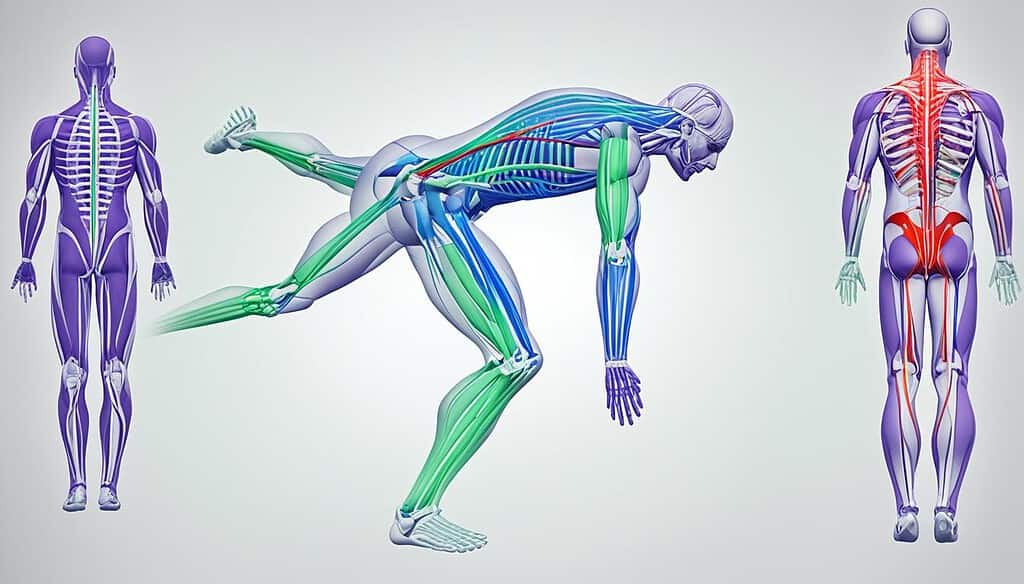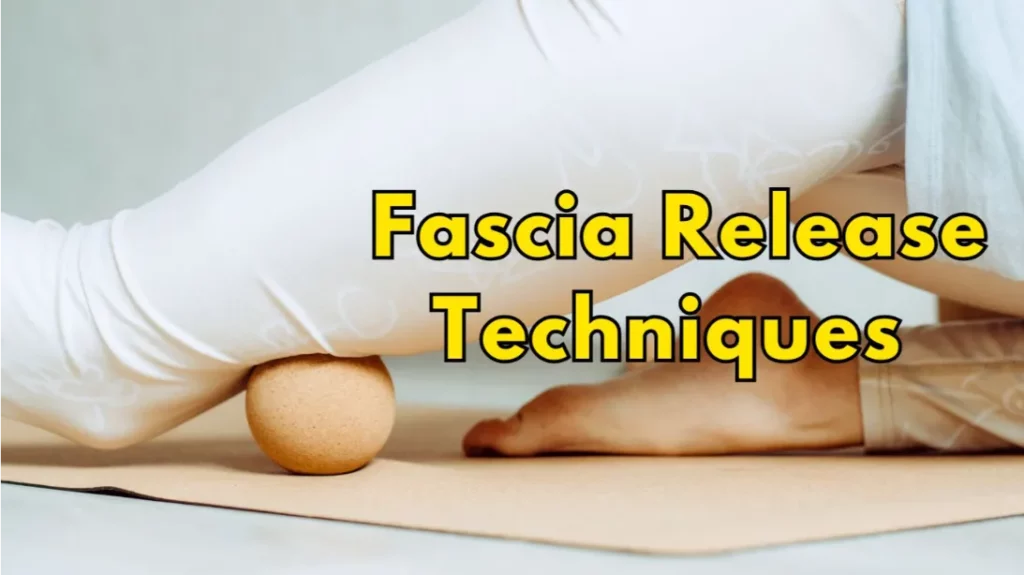Did you know that just 5 days of myofascial release can help reduce tightness and improve range of motion more effectively than stretching1? This fact shows how powerful our fascia is. It’s like a web of tissue that helps us move and stay healthy. We’ll look at how fascia release techniques can make us healthier and more flexible.

Key Takeaways
- Fascia is the most abundant tissue in the body and contains more pain receptors than muscles2.
- Doing myofascial release 2-3 times a week can help a lot. It breaks up knots and gets rid of adhesions that cause pain or limit movement1.
- Chronic or too much biofilm, plus conditions like Lyme disease and candida overgrowth, can hurt fascia health and cause adhesions3.
- Weight training makes fascia stronger. Moving and being flexible makes it more stretchy2.
- Fascia helps us feel our body and where we are in space. It has special receptors for that2.
The Mysterious World of Fascia
Fascia is a complex network of tissue that covers your body, connecting muscles and bones4. It acts like the “train tracks” of the body, helping with movement and stability4. Fascia is made mostly of collagen and has three main layers5. It’s full of nerves and has a special lubricant that helps muscles move smoothly5.
What Is Fascia?
Fascia is a key tissue that supports and connects your body’s parts456. It’s important for feeling where your body is and how it moves6. Fascia comes in different types, based on where it is and what it does6.
The Intricate Web of Connective Tissue
Problems in one area of fascia can affect other parts of your body4. If an area gets damaged, the fascia can lose its stretch, causing pain and stiffness4. Things like too much exercise or aging can hurt fascia, leading to pain and limited movement6. Issues like back pain and pelvic problems can also come from fascial problems6.
“The interconnectedness of fascia means that the source of a restriction may not be directly where symptoms are present, prompting the need for a holistic approach to treatment.”
Learning about fascia and its effects on your body is key to improving your health4. Fixing fascial issues can lead to better movement, less pain, and overall well-being456.
Myofascial Release: The Key to Optimal Movement

Doing myofascial release often is key to keeping your fascia healthy and flexible. Traditional stretching can stretch muscles but won’t fix knots in your fascia. Myofascial release uses special techniques and tools to work on the fascia. This helps get rid of adhesions and inflammation that cause pain and limit movement7.
Stretching vs Myofascial Release
Stretching is good, but it mainly works on muscles. Myofascial release focuses on the connective tissue around and through muscles. This gives a full way to fix flexibility and mobility. It makes your fascia soft and lets it move over the muscle better. This can improve your movement, coordination, and performance7.
Unlocking the Body’s Potential with Myofascial Release
Myofascial release therapy can unlock your body’s hidden abilities. It tackles the main causes of pain, stiffness, and limits. This can make muscles work better, increase movement, and improve coordination7. Studies show it can also relax you, boost blood flow, and reduce stress7. To stop stiffness, massage problem spots for at least 5 minutes a day7.
But, be careful with the pressure when you massage yourself to avoid more pain or harm7. If you have certain health issues or take blood thinners, talk to a doctor before trying it7.
“Myofascial release therapy has the power to unlock your body’s hidden potential. By addressing the root causes of pain, stiffness, and restrictions, this practice can help improve muscle function, increase range of motion, and enhance movement coordination.”
Studies say myofascial release is a great way to treat chronic pain, especially back pain8. It’s seen as a strong treatment with good evidence8. But, it might cause soreness, bruising, headaches, and dizziness8. Drinking lots of water before and after can help with detox and lessen side effects8.
Myofascial pain can come from trigger points in the tissue, causing widespread pain9. Research shows massage and other manual therapies work well for back pain9. See a therapist skilled in myofascial release for back pain relief9.
| Areas where Myofascial Tissue Often Becomes Tight |
| Arms, Calves, Feet, Head, Hips, Jaw, Lower Back, Neck, Quads, Shoulders |
In conclusion, myofascial release is a key method for better movement and performance. It targets the connective tissue to ease pain, boost flexibility, and balance your body’s systems789.
Incorporating Myofascial Release into Your Routine
Myofascial release can change your life if you do it often and in a smart way. How often you do it depends on how active you are, your past injuries, and what you want to achieve10. Doing it 2-3 times a week can really help10. It keeps your fascia flexible, stops adhesions, and brings your body back into balance11.
Adding myofascial release to your daily routine lets you take charge of your health. It helps reduce pain, makes moving easier, and boosts flexibility10.
When and How Often to Practice Myofascial Release
How often you should do myofascial release depends on what you need and want10. It’s best to do it before and after exercise, or when you feel tight muscles10. Using tools can help release tension in muscles, making you more flexible and less sore10. But, you need a professional for manual release to be safe and effective10.
Adding myofascial release to your routine can greatly improve your health11. It eases muscle tension, helps you move better, and can make you perform better in sports10.
Remember, myofascial release might make you feel sore or bruised at first. But, doing it right and listening to your body can help avoid these issues10. It’s also important to tell your therapist if you feel any discomfort to avoid nerve damage or infection10.
By making myofascial release part of your self-care, you can enjoy many benefits for your health11. Whether you do it yourself, with tools, or with a professional, it can help you manage pain, move better, and live a better life12.
| Myofascial Release Technique | Benefits |
| Self-Myofascial Release | Improves flexibility and range of motion Reduces muscle tension and soreness Can be done before and after workouts |
| Instrument-Assisted Myofascial Release | Targets specific muscle groups for relief Enhances mobility and reduces stiffness Helps alleviate post-workout soreness |
| Manual Myofascial Release | Requires skilled practitioner for safety Addresses deep-seated fascial restrictions Promotes pain relief and improved function |
“Myofascial release can help maintain a healthier, more pain-free body when integrated into daily routines.”11
Being consistent and patient is key to getting the most from myofascial release. Adding it to your daily routine can change your body, mind, and life for the better121011.
Fascia release techniques: A Holistic Approach to Healing

Fascia release techniques, like myofascial release, help heal more than just physical issues. They work on the body’s connective tissue. This can unlock hidden potential and connect the mind and body13.
Using special tools and pressure, fascia release can free emotions and memories stored in cells. This leads to feeling better and being more balanced14. It lets people take charge of their health, gaining strength in both body and mind.
Studies show myofascial release therapy is very helpful. A 2017 review found it lessened pain, improved movement, and helped with physical issues13. A 2018 study also showed it helped breast cancer survivors sleep better and feel less anxious13.
Through fascia release, we connect mind and body for deep healing. It tackles the root of pain and dysfunction, giving people more freedom and movement15. This way of caring for oneself can change lives, bringing more self-awareness and well-being.
“Myofascial Release Therapy has the power to release past physical and emotional trauma from our tissues, facilitating true healing.” –14
If you’re looking for relief from chronic pain, better sports performance, or a deeper body connection, fascia release can help. Adding these techniques to your self-care can open up new healing and wellness paths.
Addressing Common Athletic Injuries with Myofascial Release

Myofascial release is a big help for athletes and active people with common injuries and pain. It targets the connective tissue, or fascia, to ease pain and help the body work better.
Cranky Shoulders: The Teres Release
Many athletes know the pain of tight shoulders and rotator cuff tendonitis. The “teres release” method can ease these problems16. It works on the tight fascia in the teres muscles. This helps athletes move better and hurts less, letting them perform well.
Glitchy Knees: Releasing the Hip and Knee
Hips and knees hurting can slow down athletes, especially in sports like cycling or basketball. Myofascial release for the hips and knees helps a lot16. It fixes the tight fascia, making athletes more flexible and less sore. This helps them move better.
Hamstring Agony: Relief for Runners and Athletes
Runners and athletes often face hamstring pulls and strains. Self-treatment with myofascial release can really help17. It makes warm-ups and cool-downs better, improving flexibility and helping muscles recover.
Using myofascial release helps athletes avoid injuries and do better17. Foam rollers are great for big muscle groups, helping with recovery and flexibility17. Manual myofascial release gives athletes personal care, which helps them recover faster17.
Myofascial release helps with tight shoulders, knee pain, and hamstring issues. It’s a full approach to preventing injuries and improving sports performance16. Athletes who use these methods can reach new heights in their sports.
The Revolutionary Work of John F. Barnes, PT
John F. Barnes, PT, is a key figure in myofascial release and fascia therapy. He spent decades unlocking the body’s hidden potential. After a bad back injury, he looked for new ways to heal. He found fascia and developed new techniques that help many with pain.
His work has trained over 100,000 therapists, doctors, and surgeons18. These techniques help athletes and fitness lovers by easing muscle tension, improving blood flow, and helping them relax18.
John F. Barnes’ method checks the whole body for deep and lasting results18. It helps with chronic issues like fibromyalgia, headaches, and fatigue without surgery18.
A session with him can last an hour and includes hands-on treatment and self-help tips18. Regular sessions boost mobility, cut pain, and make you feel better overall. It’s great for preventing injuries, managing chronic pain, and helping with sports medicine18.
John F. Barnes has taught for over 40 years, sharing his discoveries19. He’s trained over 100,000 therapists19. His work is so popular, therapists are booked solid months ahead20.
His method is safe, gentle, and works well for lasting results19. It uses pressure, chaos theory, and phase transition to heal and match vibratory rates for deep effects19.
John F. Barnes has changed many lives and taught a new generation of therapists about myofascial release and fascia therapy. His work inspires healthcare pros to use non-invasive methods for pain, dysfunction, and injury prevention181920.
For those interested in exploring more advanced fitness techniques, consider learning about chronobiology in fitness or hormetic stress workouts to further optimize your physical performance and overall well-being.
Conclusion
Thinking about fascia release techniques, like myofascial release, amazes me. They deeply affect our health, both physical and mental. By learning about the connective tissue, the fascia, we see how it helps our body work right21.
Using self-treatment or getting help from experts has changed my life. These methods have helped me heal from injuries, improve in sports, and stop new problems. This lets me do more in my body’s limits21.
John F. Barnes, PT, and others have greatly helped us understand and use fascia release. Their work gives us a way to be healthier and enjoy life fully2223.
To further enhance your fitness journey, explore neuroplasticity and exercise connections, breathwork for athletic performance, and mobility flow routines. These techniques, combined with fascia release, can provide a comprehensive approach to holistic wellness optimization.
Source Links
- The Body Method — Exploring Myofascial Release: Your Body’s Hidden Network – https://www.thebodymethod.com.au/blog/what-is-myofascial-release
- A Comprehensive Guide to Myofascial Release | Stretch Therapy – https://stretchtherapy.net/myofascial-release/
- Simple Ways to Care for Your Fascia — Healing Masters – https://www.healingmasterscoaching.com/blog/fascia-and-lymph
- The Mysterious World of Fascia – Massage by Maple – https://massagebymaple.com/blog/the-mysterious-world-of-fascia/
- Fascia: The Mysterious Tissue – N2 Physical Therapy – https://n2physicaltherapy.com/b-fascia-the-mysterious-tissue/
- An Expert Guide to Your Fascinating Fascia & Myofascial Release | Origin – https://www.theoriginway.com/blog/an-expert-guide-to-your-fascinating-fascia-and-how-to-stretch-it
- What to Know About Myofascial Release Therapy – https://www.webmd.com/pain-management/what-to-know-myofascial-release-therapy
- Myofascial Release: A 101 Guide to Your Full Body Relief – https://mountainviewmovement.com/myofascial-release-a-101-guide-to-your-full-body-relief/
- Can myofascial release relieve back pain? – https://www.mayoclinic.org/diseases-conditions/back-pain/expert-answers/myofascial-release/faq-20058136
- What are 3 myofascial release techniques – https://www.mfrptwellness.com/post/what-are-3-myofascial-release-techniques
- Myofascial Release Guide: Benefits & Techniques – https://www.reverseeffects.com/myofascial-release-techniques/
- Daily Myofascial Release: Pain Relief & Wellness – https://www.southwesthealing.com/implementing-myofascial-release-in-your-daily-routine/
- Research And Evidence Supporting Effective Myofascial Release – Release Works Myofascial Therapy – https://www.myofascialreleaseofsaltlake.com/research-supporting-effective-myofascial-release/
- The Benefits of Myofascial Release Therapy | A Holistic Approach – https://wholisticphysicaltherapy.co/myofascial-release/
- Myofascial Release (MFR): An Overview – HSS.edu – https://www.hss.edu/conditions_myofascial-release-overview.asp
- Fascia and Myofascial Release – https://www.dynamicsportsmedicine.com/blog/what-is-fascia-and-myofascial-release/
- Enhance Sports Performance with Myofascial Release | Agape Health – https://www.agapehealthlv.com/blog/2024/2/3/enhance-sports-performance-with-myofascial-release
- Introducing The Myofascial Release Therapy | Release Works – https://www.myofascialreleaseofsaltlake.com/myofascial-release-therapy-2/
- PDF – https://www.myofascialrelease.com/downloads/brochures/Myofascial-eVersion-Jan-2014.pdf
- PDF – https://myofascialrelease.com/downloads/brochures/myofascial-brochure-eversion.pdf
- PDF – https://www.logan.edu/mm/files/LRC/Senior-Research/2011-Aug-34.pdf
- The impact of myofascial release and stretching techniques on the clinical outcomes of migraine headache: A randomized controlled trial – https://www.ncbi.nlm.nih.gov/pmc/articles/PMC8384005/
- The Power of Myofascial Release Therapy for Pain Relief and Improved Mobility – https://www.familychiroplus.com/title-the-power-of-myofascial-release-therapy-for-pain-relief-and-improved-mobility
As a veteran fitness technology innovator and the founder of GearUpToFit.com, Alex Papaioannou stands at the intersection of health science and artificial intelligence. With over a decade of specialized experience in digital wellness solutions, he’s transforming how people approach their fitness journey through data-driven methodologies.
